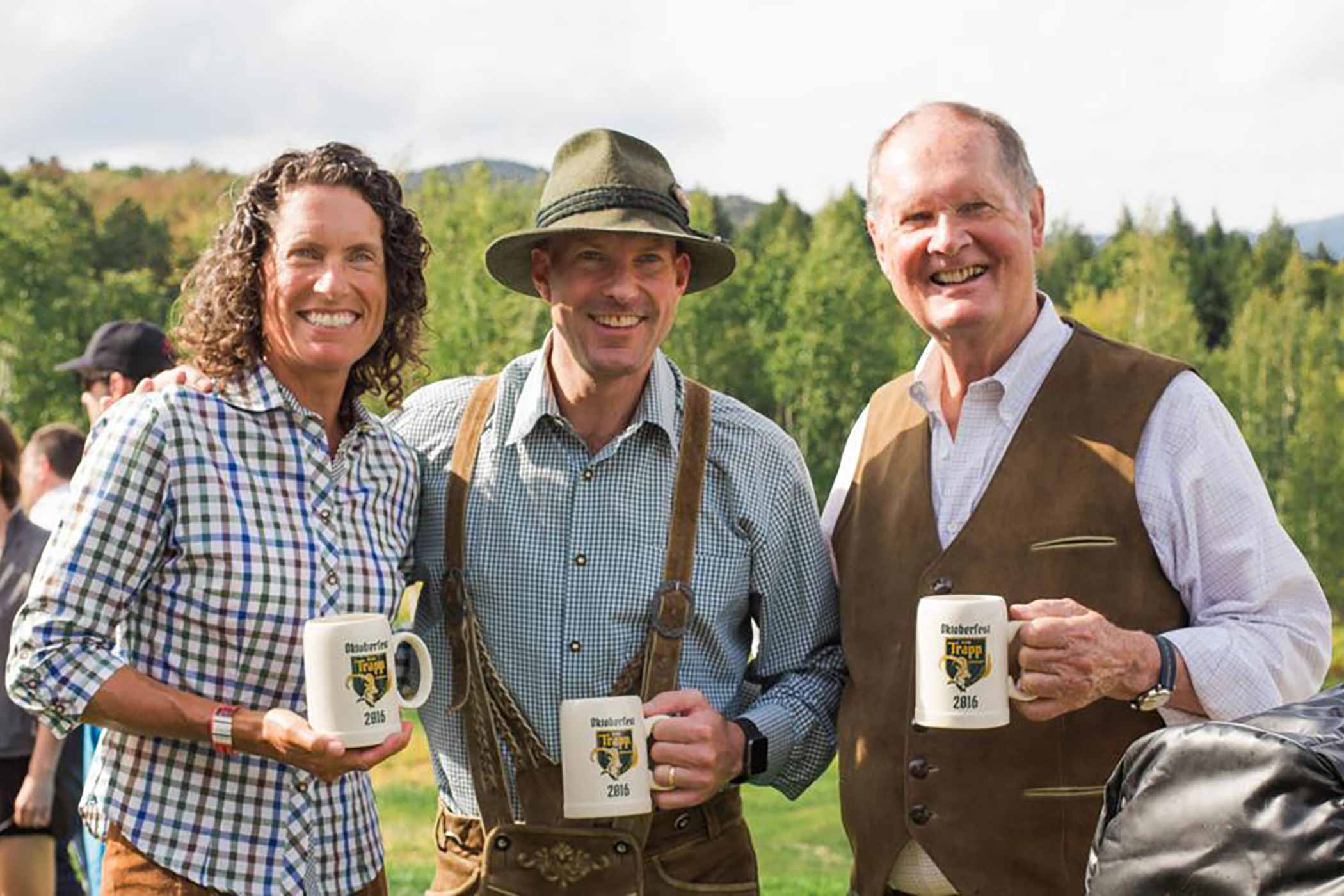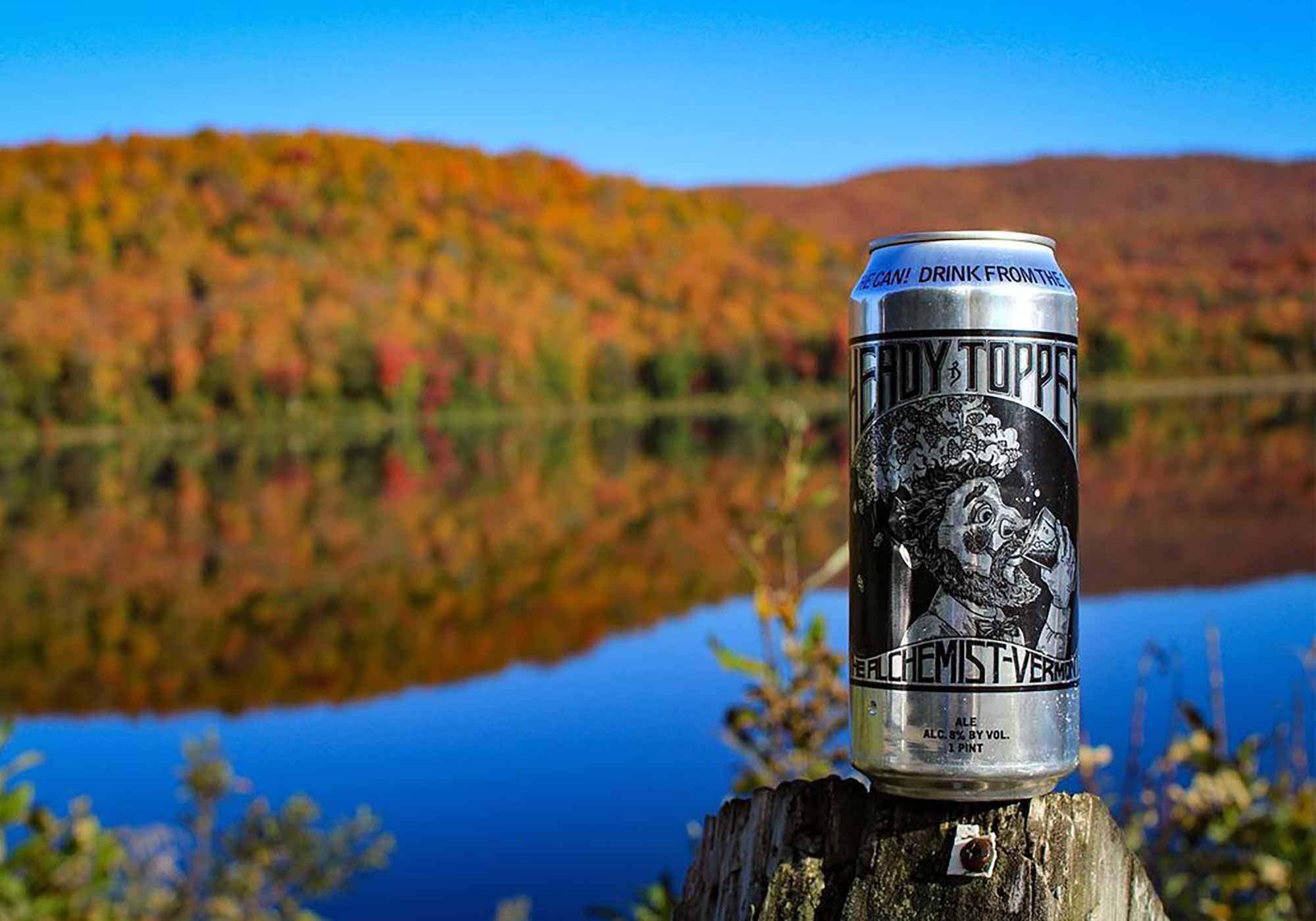Shop
At von Trapp Brewing, The Helles Are Alive With the Rounds of Beer
Looking for More?
Any day at around 4:30 p.m., Sam von Trapp’s cell phone might ring. “If it says Pop’s cell … I know there’s a good chance he’s calling to say, ‘Want to go have a beer?’” says the director and executive vice president of idyllic Stowe, VT-based von Trapp Brewing, whose Stowe Style Festbier we named one of the “Best Beers We Drank in 2023.” “I’ll pretty much drop anything that could be dropped to go.”
Family is everything at von Trapp, the second-generation brewery that evolved from a family ski lodge opened in the 1950s.
When you’re drinking a beer after a hard day of snowshoeing or skiing and looking around at the beautiful mountains, you feel like you’re part of the von Trapp family legacy.
And you might just get to thinking: von Trapp, now where have I heard that name before?
Well, if the hills are alive with the sound of music, then at von Trapp, the hills are alive with the taste of beer.
From Sound of Music to Taste of Beer
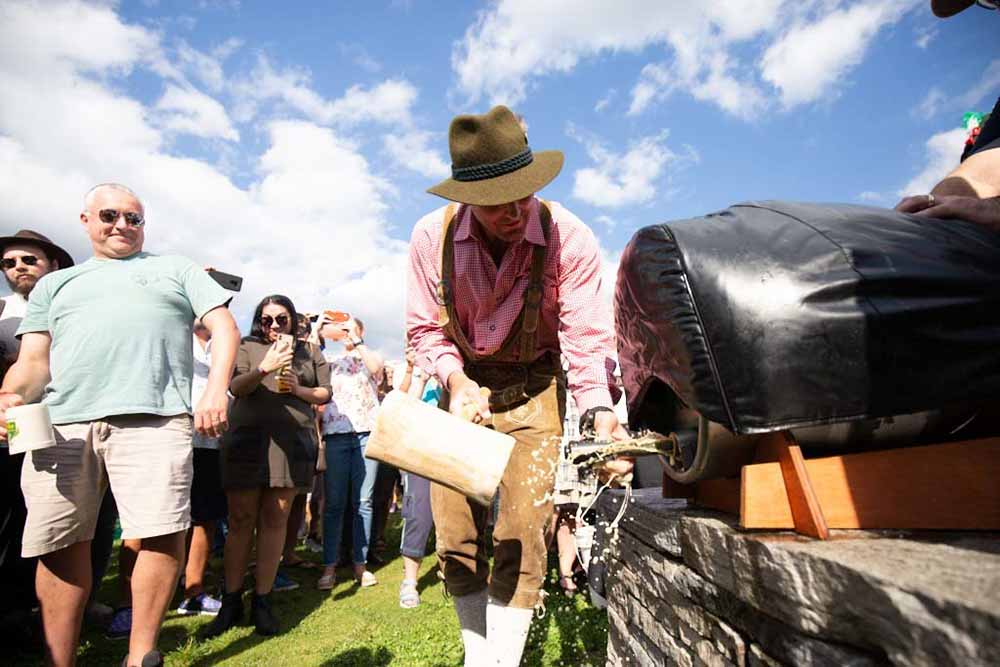
Photography courtesy of von Trapp Brewing/Trapp Family Lodge
Perhaps you’ve heard of the von Trapps?
Maybe in a little motion picture released in 1965 called “The Sound of Music.”
“It’s based on the book that my grandmother Maria [von Trapp] wrote,” says Sam.
Yes, these are the von Trapps, the very same.
But if the “Sound of Music” in all its Julie Andrews glory captured the von Trapps’ story of survival, the brewery today carries on a different legacy: What happens after the credits roll?
In 1938, the von Trapp family fled Austria, immigrating to the United States to escape the Nazis and Hitler-led Germany.
As professional singers, the von Trapps made a name for themselves, singing and traveling all around the U.S. and the world, eventually settling in Stowe because they “spent the summer here, fell in love with it, and bought a farm,” laughs Sam. “They really appreciated these beautiful views of the hilltop farms.”
According to Sam, the family got a good deal on one of those hilltop farms and bought the neighboring one a year later.
In 1950, the von Trapps turned the family home into a hotel, Trapp Family Lodge, renting rooms to skiers who came to Stowe to enjoy the first chairlift for downhill skiing in the eastern United States and only the second one in the entire country.
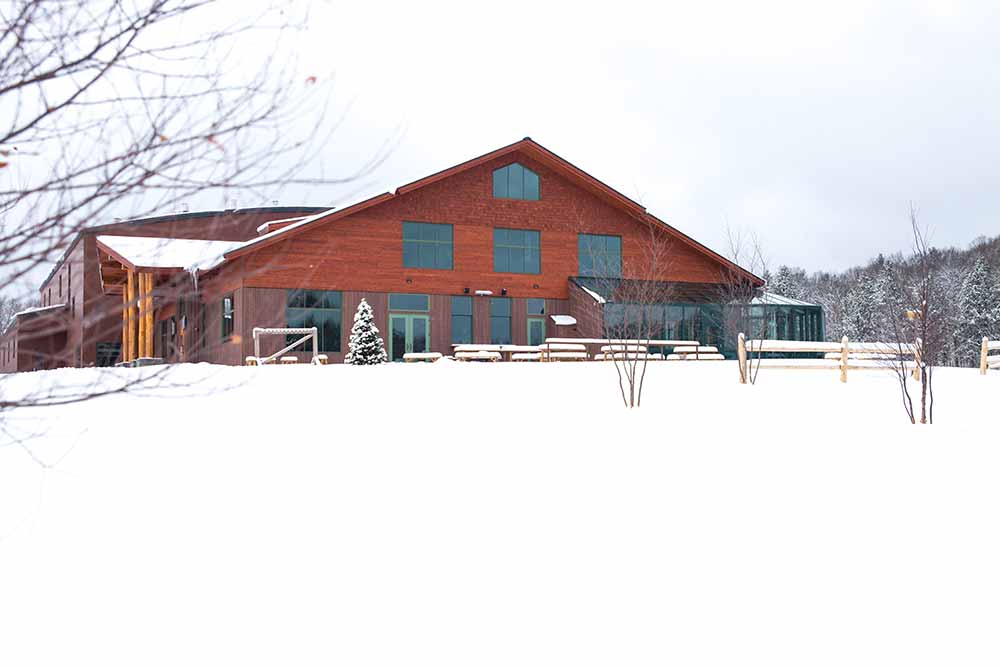
Photography courtesy of von Trapp Brewing/Trapp Family Lodge
By the 1960s, Sam’s dad, Johannes von Trapp (one of three of Georg and Maria’s kids), returned to the family business. Initially interested in working for the foreign service as a diplomat, Johannes “just kind of got stuck in the family business,” shares Sam.
The outdoors is life at Trapp Family Lodge, like taking a deep breath before starting to sing. The mountains and hills are truly alive in all of von Trapp’s veins.
Johannes himself explored and mapped out the early ski trail system at the lodge. Even today, Sam keeps a pair of the classic style of wooden skis, which Johannes learned to ski on, in his office, propped up in the background during our Zoom call next to a couple of photos from Ned Gillette, “one of the first professional expeditionists who learned that he could make a living following adventure,” Sam explains. Gillette spent a few years in the 1970s running the Trapp Family Lodge’s Cross-Country Ski Center. (“He only agreed to work for us after getting quite a few beers into my dad, so he could see what sort of person he really was!” Sam shares.)
An avid skier, Sam worked in the ski industry straight out of college before following in his father’s footsteps and returning to run the now 2,600-acre lodge with his sister and brother-in-law in 2007.
With both of his kids back home, Johannes felt reinvigorated, according to Sam, picking up a tiny little idea he’d been mulling on for quite some time.
During the ‘90s, Sam fell in love with craft beer. He cites Pete’s Wicked Ale as one of his go-to’s at the time. “It’s funny because that often gets a smile from people when I bring up that [beer],” he says.
Sam tried to get his dad to try some of those early craft ales, but he didn’t quite understand. “I see what you’re talking about, but where are the lagers?” Sam says he asked. “He was really wondering why lagers were so underrepresented in the craft beer scene back then, and he started thinking about creating his own brewery.”
So, despite the Great Recession, in 2008, Johannes started the brewery with “cobbled together” equipment, says Sam, noting they ran out of money four times during the build-out.
“We got the building built, but we couldn’t bring in the brewing equipment…we had beer in the tanks, but we didn’t have a bottling line yet…we had a facility operation without a restaurant for a year and a half,” laughs Sam.
But the von Trapps persevered, hurtling forward like a skier down the mountain with one focus in mind: lagers.
What the Helles!?
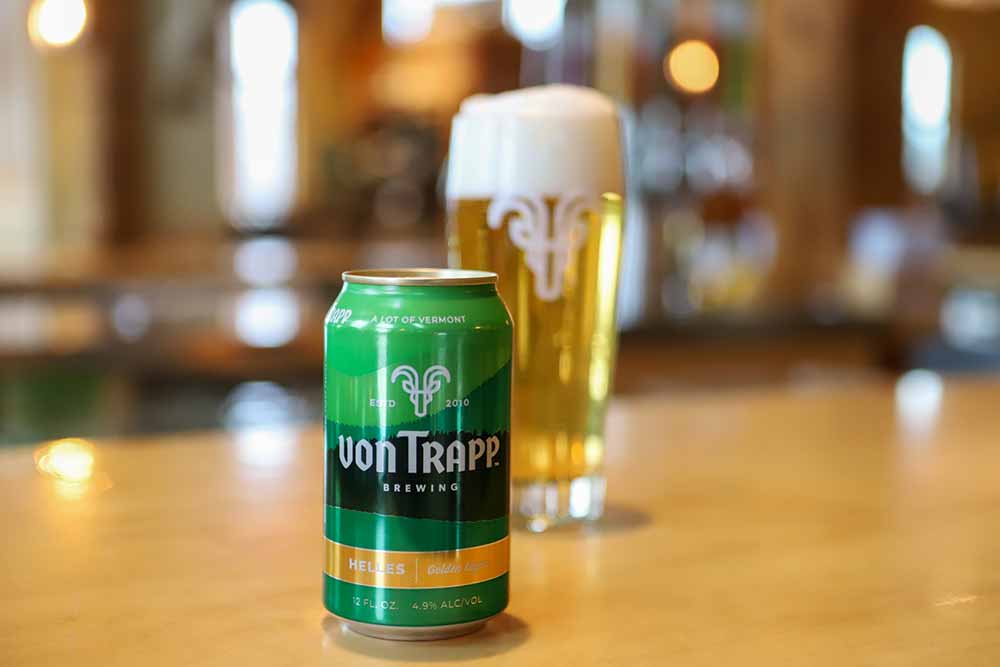
Photography courtesy of von Trapp Brewing/Trapp Family Lodge
“The helles is what my dad really had in mind for the beer he wanted to create,” explains Sam.
With roots from the Salzberg, Austria, and Bavaria, Germany, region, Johannes wanted to recreate the crisp, clean, time-honored lager you’d often find in this area.
But one, at the time, you’d rarely find in the United States.
“I don’t know if any other brewery in the country was even selling a beer they called helles,” says Sam. “I certainly didn’t know what a helles was … you weren’t really seeing the word ‘helles’ on the shelf a whole lot.”
Sam applauds his dad for taking what seemed like a bold, brash approach to brewing in the early 2000s.
“He recognized that there was a thirst for those styles of beer, a space for them at a time when there was such a heavy focus on different styles of beer, and his willingness to commit, double down, and just focus on lagers,” he says.
Of course, lagers have accrued that “hipster” tag today, but at the time, the best Johannes could find was Heineken and Spaten.
“That was the one beer he liked the most,” says Sam. “For the four draft lines we had at Trapp Family Lodge, Spaten was always on the lineup.”
And when they did blind tastings to develop the initial von Trapp Brewing recipes, “all of us scored Spaten the highest,” recalls Sam. “Basically, he was saying I want to try to replicate that crisp, clean lager that I have when I go to Austria, where you can drink it with lunch and not fall asleep afterward.”
In the late 2000s, very few breweries made only lagers, but von Trapp’s started to echo across the mountaintops.
So much so that Sam says John Kimmich, co-founder of The Alchemist about three miles as the crow flies from von Trapp, offered Sam a trade. “A case of Heady Topper sixteen-ouncers for a case of our Helles twelve-ouncers,” Sam recalls. “Just because John really wanted to drink that crisp, clean beer!”
Brewing That Perfect Alchemist-Approved Helles
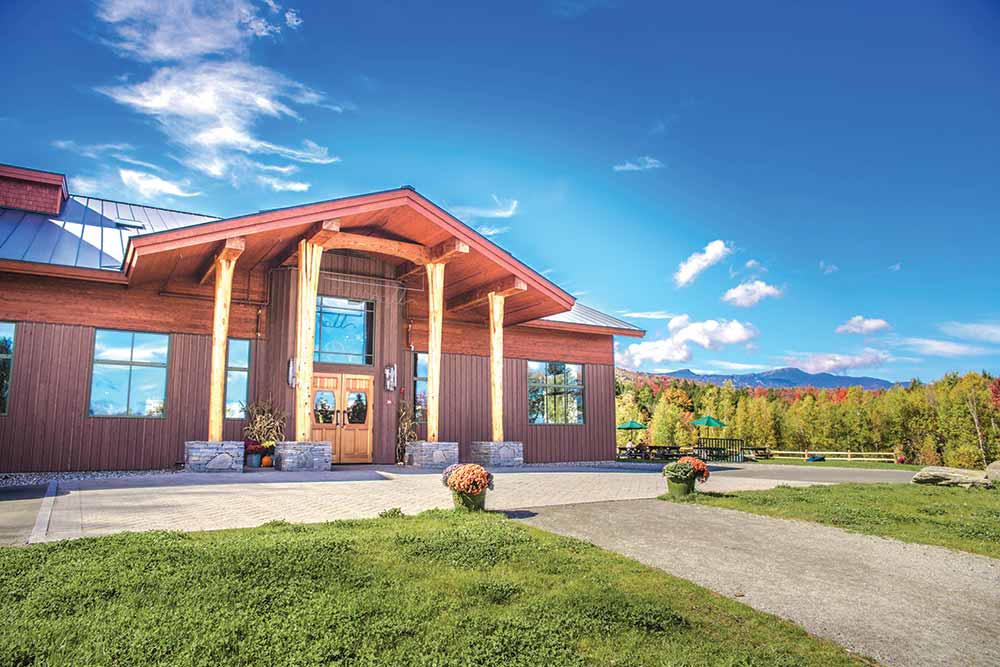
Photography courtesy of von Trapp Brewing/Trapp Family Lodge
At von Trapp, everything starts with the perfect water source, which, Sam jokes good-naturedly, is a little bit magical at the von Trapp Brewing.
“I love telling the spring story,” he regales. “I often don’t get enough time to tell it.”
In search of a reliable source of water for the hotel, Johannes procured an 1898 USGS survey map. “He found this blue circle with a little stream flowing out of it only a few miles behind the hotel,” Sam tells me. “He thought, ‘Wow, this looks like a spring!’”
Sure enough, a short hike out, Johannes discovered this new-found water source. After figuring out who owned the land, he bought it, installed an underground pipeline, and began bringing fantastic drinking water to the hotel, his house, Sam’s house, and their sugar house (where the von Trapps make maple syrup).
By the early 2000s, the hotel had grown to the point where the family needed to go to the town for its water supply, so the von Trapps diverted the water to a snowmaking system Sam developed.
“The spring is really close to both of our hearts,” says Sam, who spent his first two years running all the night snowmaking shifts. “It has been a labor of love on my father’s part and a labor of love on my part.”
And years later, in 2015, when von Trapp Brewing expanded to a new facility, the spring came to the rescue again.
“As Murphy’s Law would have it, that spring was the most perfect for brewing and was the one furthest away,” says Sam. “So that water now flows about two and a half miles through an underground pipeline.”
But Sam hit on the gold nugget: The spring gives water with a “perfect mineral profile for brewing these European styles of lager,” he says.
Von Trapp Quality Manager Jack van Paepeghem explains that the brewery’s Stowe-bound spring-fed water is similar to what you might find in Plzen, Czech Republic. “That really sets the base for us to brew great, clean, easy-drinking lagers with no distractions, no harsh salt or mineral character,” he says. “It’s just the perfect base for everything else that follows.”
Four Ingredients, Five Year-Round Beers
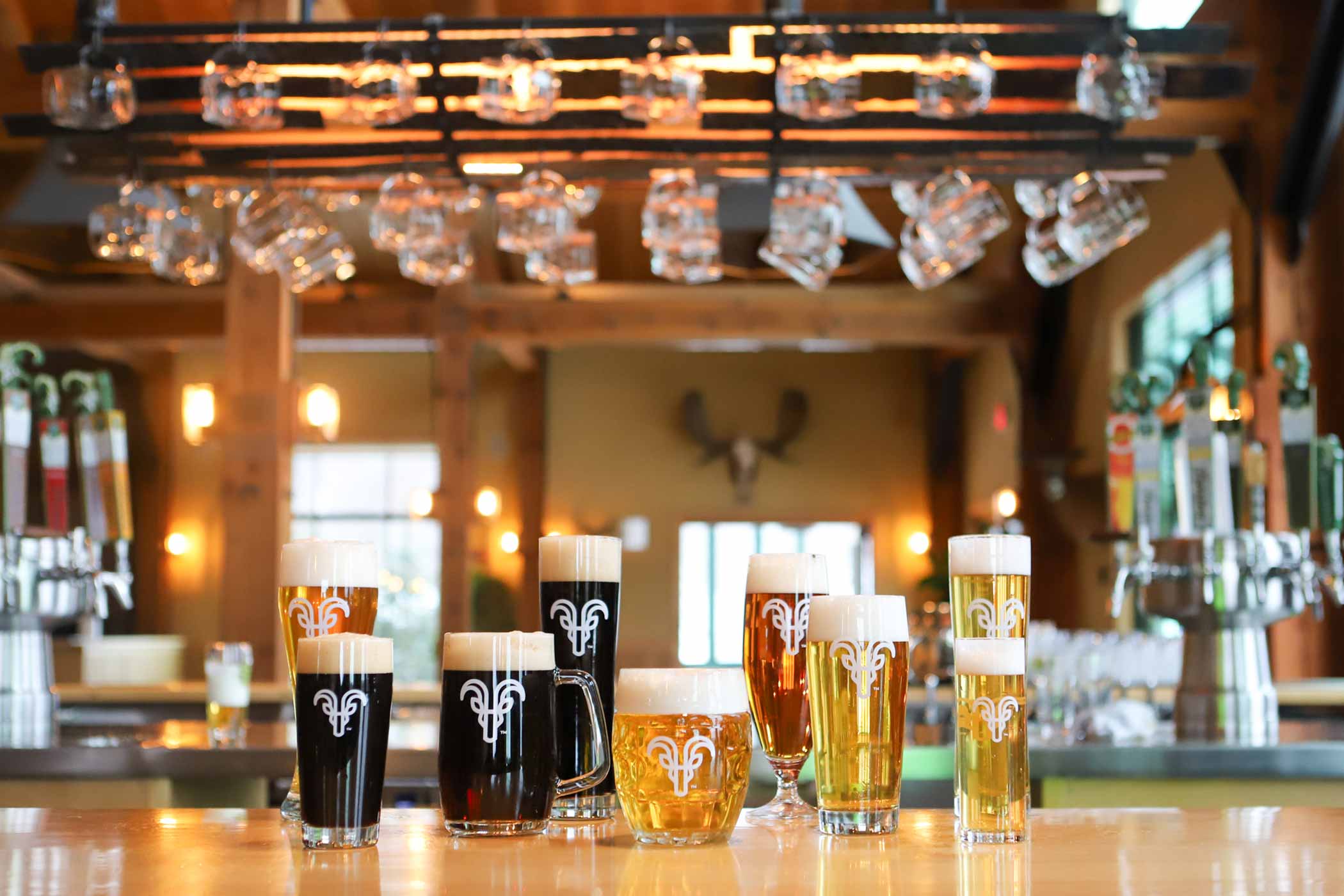
Photography courtesy of von Trapp Brewing/Trapp Family Lodge
At von Trapp, brewing boils down to just a few things. Four to be exact.
“We really embrace patience, simplicity, nuanced subtlety, and letting the beer speak for itself,” says van Paepeghem. “We only use four ingredients, so those have to be the best four ingredients.”
Such as Weyermann malts from Bamberg, Germany. Van Paepeghem says they use Weyermann’s Pilsner, Vienna, and Munich malt in pretty much all of von Trapp’s beers. “It’s just super clean and high [quality],” he says.
And although hops aren’t always the star, they still get the von Trapp treatment.
“We’re not double dry hopping, doing anything too crazy,” says van Paepeghem. “We’re just using good amounts and small quantities, making sure they’re top-notch.”
For example, Czech-grown hops for the award-winning Bohemian Style Pilsner, Bavarian-grown hops for the Helles and Vienna Style Lager, “no curve balls … just the good old Noble varietals to do the heavy lifting,” says van Paepeghem, and even some Michigan-grown ones go into the pilsner, too. “It’s kind of a grab bag, but it really works.”
Which works for van Paepeghem, who attended the Siebel Institute and spent a month brewing in Bavaria.
Funny enough, before van Paepeghem joined von Trapp in October of 2020, he ran Oxbow’s quality control (QC) program.
“I learned everything about wild yeast and bacteria—everything we don’t want in our beer here at von Trapp,” jokes van Paepeghem.
At von Trapp, van Paepeghem cleaned out an old office collecting dust to start a fully functioning QC lab from scratch, now an essential part of ensuring each of von Trapp’s core beers comes out as close to perfect as possible every time.
Although van Paepeghem will be the first to tell you a beer is never perfect; it’s a living, breathing, evolving liquid. “Don’t believe anyone who says their beer is ever perfect,” he says. “We’re always improving and working on efficiencies; it’s just a really great place to make great beer.”
The Always-Getting-Closer-to-Perfect Helles
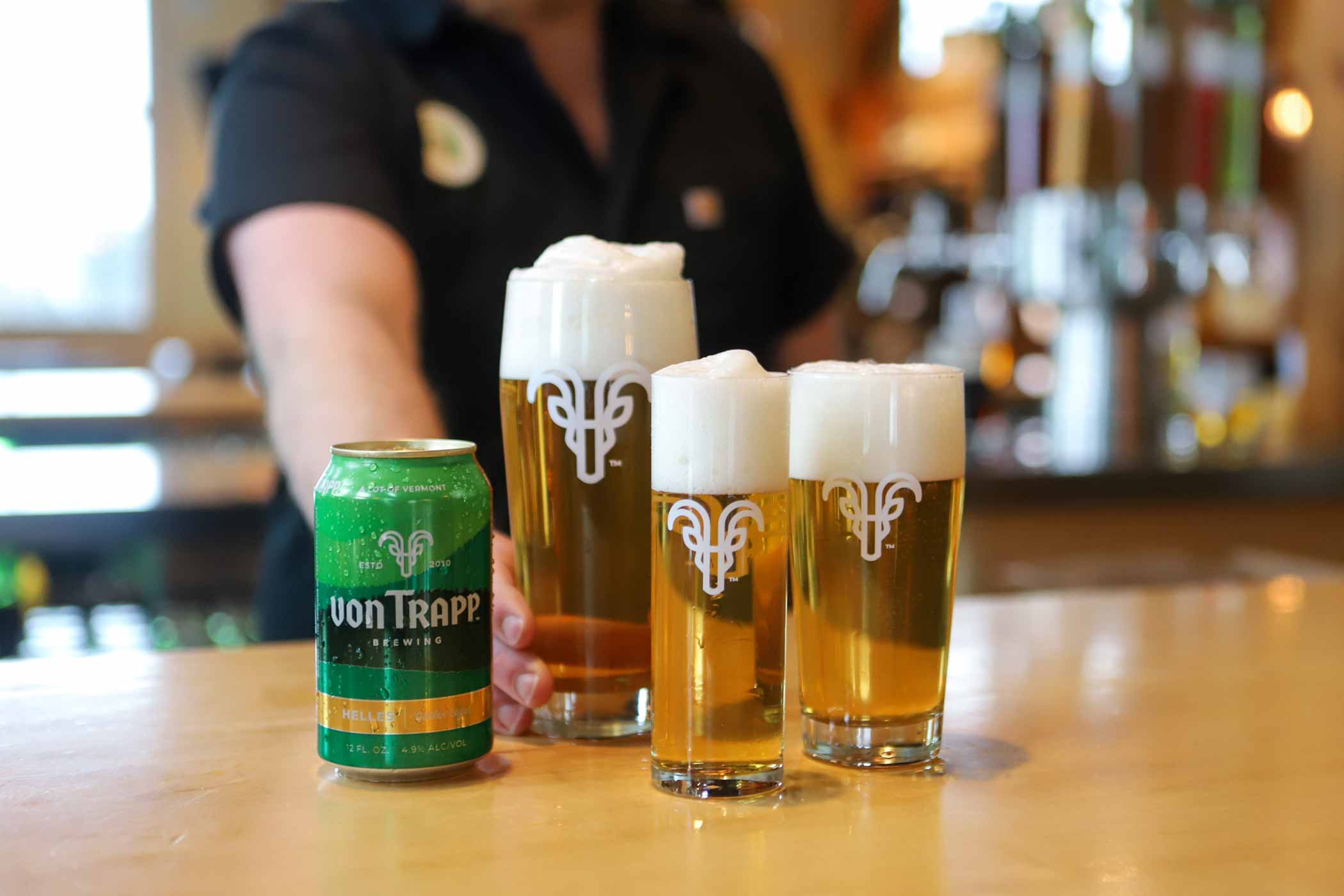
Photography courtesy of von Trapp Brewing/Trapp Family Lodge
This beer started it all.
Von Trapp’s helles is a contradiction of sorts—simple yet complicated, which is precisely what makes it a star.
“The beauty of this beer is that it’s so simple, but that’s also the most difficult thing about it,” says van Paepeghem. “There’s so many ways you can mess it up.”
But with van Paepeghem running QC with a sensory program and can testing, there’s a much lower chance of that happening.
Like everything at von Trapp, the Helles starts with fantastic water, followed by simple, high-quality ingredients: pilsner malt, Noble hops, and “good, healthy” yeast, according to van Paepeghem.
Following a step mash instead of decoction, the Helles includes a ninety-minute boil before fermenting for fourteen days and lagering for another forty to fifty days, depending.
For a final step, Von Trapp naturally carbonates with a spunding device.
“Really not a lot that goes in it, but there’s so much that goes behind it,” says van Paepeghem. “Just good water, good Pilsner malt, a few different Noble hops, and it’s a thing of beauty.”
Van Paepeghem adds, “When Helles is at its best, you don’t have to think about it. You can just enjoy it and drink it. Nothing’s off; nothing singing too loud. It’s just balanced, smooth, super drinkable, and always one of our favorite beers to make.”
And one of their favorite to drink.
At only 4.9% ABV and 20 IBUs, Helles is “the perfect example of that crisp, clean lager my dad wanted to have for all those years,” says Sam, who admits it’s his go-to.
And not just because he loves the taste. This beer has a connection to Sam as deep as their on-site spring.
“The fact that I get to sit down with my dad, who is now eighty-five, and [drink a Helles]; I enjoy every moment I spend with him,” says Sam.
That’s why Sam will drop everything when his Pop calls at 4:30 p.m. asking to grab a beer. “I know if I’m going over to his house for dinner, I don’t have to ask what beer to bring,” says Sam. “It’s funny, but he would have made only Helles to start with, and I was the one who said, ‘Hey, Pop, I think we should make a few others!’”
The Award-Winning Bohemian Style Pilsner
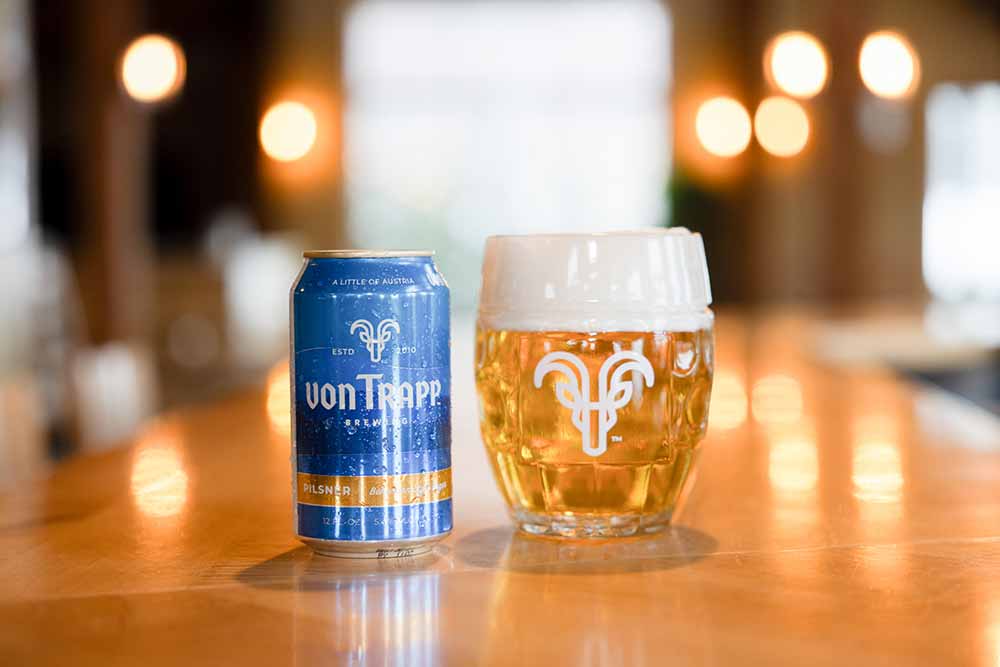
Photography courtesy of von Trapp Brewing/Trapp Family Lodge
Such as the number-one selling pilsner.
“Because as much as I love to talk about our Helles, our pilsner is actually our biggest beer these days,” says Sam.
In fact, the Bohemian Style Pilsner has won numerous awards, including silver at the Great American Beer Festival in 2015 and the 2023 World Beer Cup.
After opening with three core beers—Helles, Vienna, and Dunkel—von Trapp got a special request from a hotel in Burlington: to make a pilsner.
“I have such clear memories of sitting down with JP [our head brewer at the time] and talking about what we wanted this pilsner to be,” says Sam. “We wanted to make something hoppier that still fit into the European styles we were making.”
At 42 IBUs, Bohemian Style Pilsner adds a pretty hoppy beer to von Trapp’s lineup.
“When it took home the silver medal at GABF … that was a really huge moment for us,” says Sam. “We were just so proud.”
Van Paepeghem says the secret to Bohemian Style Pilsner’s success starts with treating the malt gently. “We’re not killing it with such a long boil or a hard mash,” he explains. “We’re gentle when we’re transferring it.”
And it ends with careful lager fermentation. “A lot of people think … Oh, it’s cold; nothing’s happening,” says van Paepeghem. “But there’s a really delicate period between when we first knockout and introduce the yeast.”
He explains that von Trapp treats every step of fermentation gently from a diacetyl rest where they raise the temperature a little bit at a time to a step chill, “so we don’t crash the yeast and shock it,” he says. “Pilsner is probably my number one [beer] that I’m most proud of and is the most fun to drink.”
The Dunkel Lager That Makes People Love Dark Beer
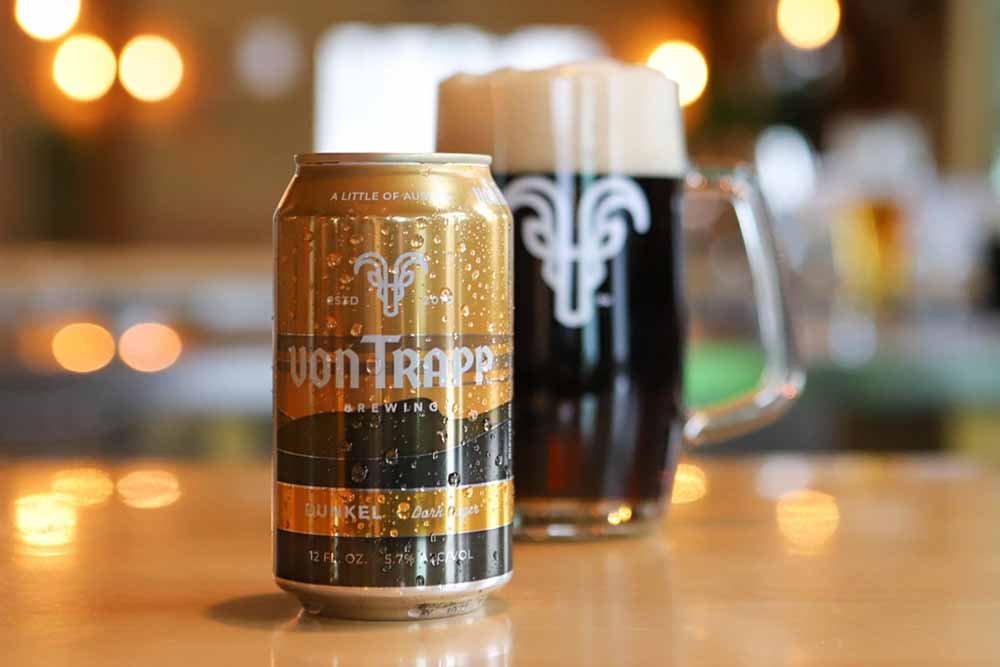
Photography courtesy of von Trapp Brewing/Trapp Family Lodge
While Sam firmly admits that the Helles is his go-to, the one he’s usually drinking, he does have a special soft spot for von Trapp’s dunkel.
In fact, the dunkel was the first von Trapp beer Sam drank on draft in the Trapp Family Lodge right before the brewery officially opened. “I remember having it with my dad, and I remember who was in the bar that night; it was just a really special moment,” he says. “It was so magical to finally drink our new beer in the hotel, and to start with that silky, rich, roasty-flavored Dunkel just seemed appropriate.”
In the hotel in italics because it was the same day Vermont changed a law allowing the Trapp Family Lodge to pour beer at the hotel. The law previously said beer must be brewed on the premises to sell it. Technically, von Trapp Brewing brewed in a different building, so Johannes petitioned the Vermont Liquor Control to clarify the word “premises.”
“We changed the law but only got it enacted a few days before our massive rollout party,” says Sam. One could say that the first sip of dunkel was a little taste of the future.
“I think [the dunkel] just changes a lot of people’s perspective on what a dark beer can be,” he shares. “We heard over and over again people saying things like, ‘You know, I don’t really like beer that much, but I like your beer.’ And, ‘I don’t really like dark beer, but I like your dark beer.’”
Sam takes great pride in his dad and his vision to “provide the American beer drinker something that hadn’t been available to them before,” as he says.
It’s a vision he continues to admire even as von Trapp looks to the future.
A Classic Core, A Contemporary Style
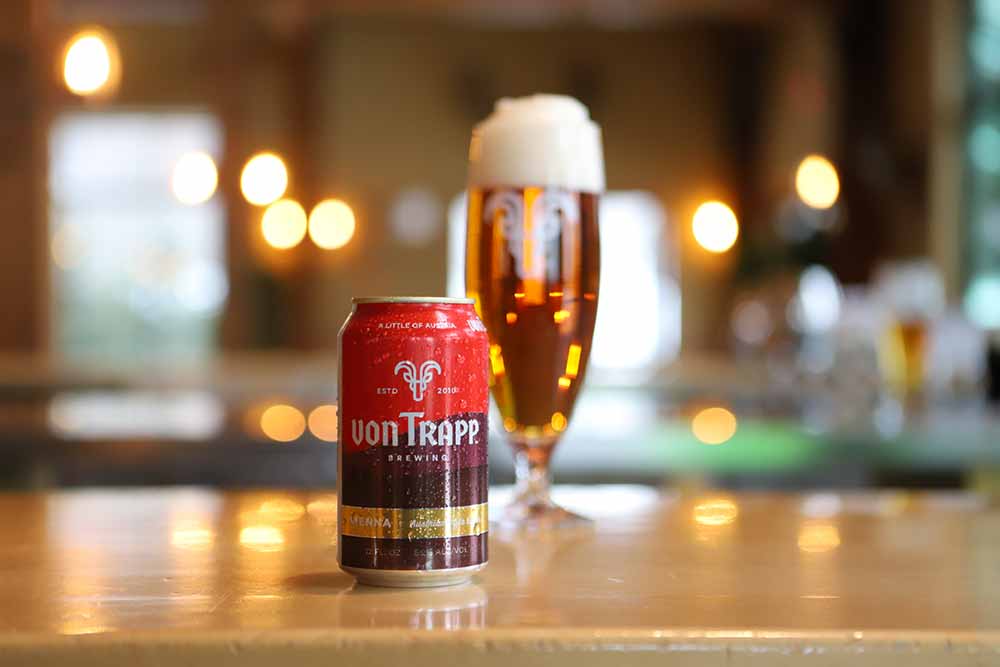
Photography courtesy of von Trapp Brewing/Trapp Family Lodge
Von Trapp recently celebrated a complete rebrand, moving toward a more straightforward packaging and logo that still evokes von Trapp’s crucial Austrian and Bavarian feel. “We’re helping usher in a new generation of beer drinkers,” says Sam. “Something that will resonate with more people.”
Designed by Ryan Thibault, von Trapp’s new cans feature various shades of color “so when you see them on a shelf, it’s really easy to pick out,” shares Emily Provost, marketing manager at von Trapp. “Pilsner is blue now—that’s what I need to look at; that’s what I want to grab. It’s really easy to see the beers that you love on the shelf and in the cooler.”
To bring everything full circle, each can has a landscape etched into the background—actual scenes viewable from different places around the von Trapp property. (An idea Sam contributed to the rebrand.)
For instance, Helles includes the sprawling wilderness backdrop behind the von Trapp Meadow Stage, from which you can see Nebraska Valley’s expanse to the Southwest, nestled between the Little River, Bolton Mountain, and Skytop Ridge.
While Bohemian Style Pilsner sports a view from von Trapp Brewing’s birthplace, the Kaffeehuas, a bakery on the property. “It’s the original brewery location and where we brewed our first-ever batch of beer,” Provost tells me. “From the bakery looking east, the iconic peaks of the Worcester Range run north to south, framing the eastern flanks of the Stowe valley.”
Von Trapp Family Brewery
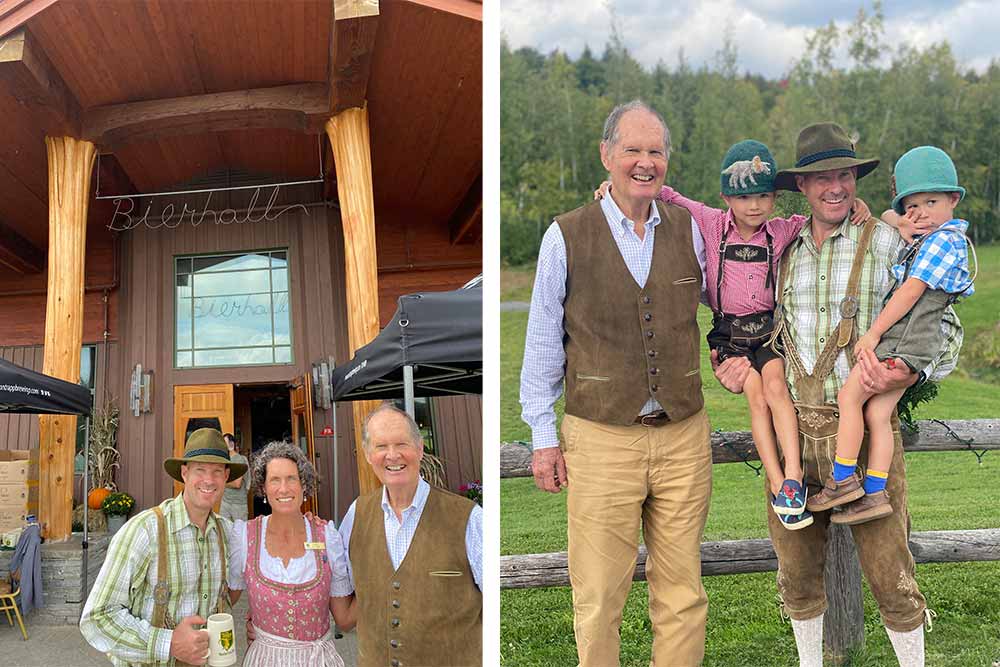
Photography courtesy of von Trapp Brewing/Trapp Family Lodge
Family is everything up in those Bolton mountains. For so long, the von Trapps carried the endowment of “The Sound of Music.”
“I could not count the number of times that one of the servers in the beer hall has come over and said, ‘Sam, I got this really nice family, and this eleven-year-old would just love to meet you.’ And I’ve never, ever regretted going over and talking to those people,” he says.
But at times, this family birthright became more of a weight than a worth for Johannes.
“My dad dealt with that legacy pretty much his whole life,” says Sam, who never actually sang on stage. “I’d say, ‘You know, Pop, they’ve handed you a podium and given you a chance to speak. What do you want to speak about?’”
Connecting with nature, providing a place where people can come to get away, and, at the end of a long, fulfilling working day, shoving off maybe a little early at 4:30 p.m. to go drink a Helles with your family.
Yes, the von Trapps carry on a legacy, but that doesn’t mean it has to be the one memorialized in a movie.
Von Trapp Brewing has written a new future for the family, a word that now encompasses everyone who works and passes through the lodge and brewery.
“I look forward to seeing some of the people here with us at the beginning, having their kid’s twenty-first birthday beer at our beer hall,” says Sam with a smile.
While you won’t find Johannes singing around the world these days, if you find him drinking a Helles in the Trapp Family Lodge or the brewery and there’s a celebration, you might just be lucky enough to hear him jump in with his son Sam and sing happy birthday.
“I can go over later and say, ‘I don’t know if you’re aware, but that was one of the original von Trapp family singers who was just singing for you,’” says Sam.

